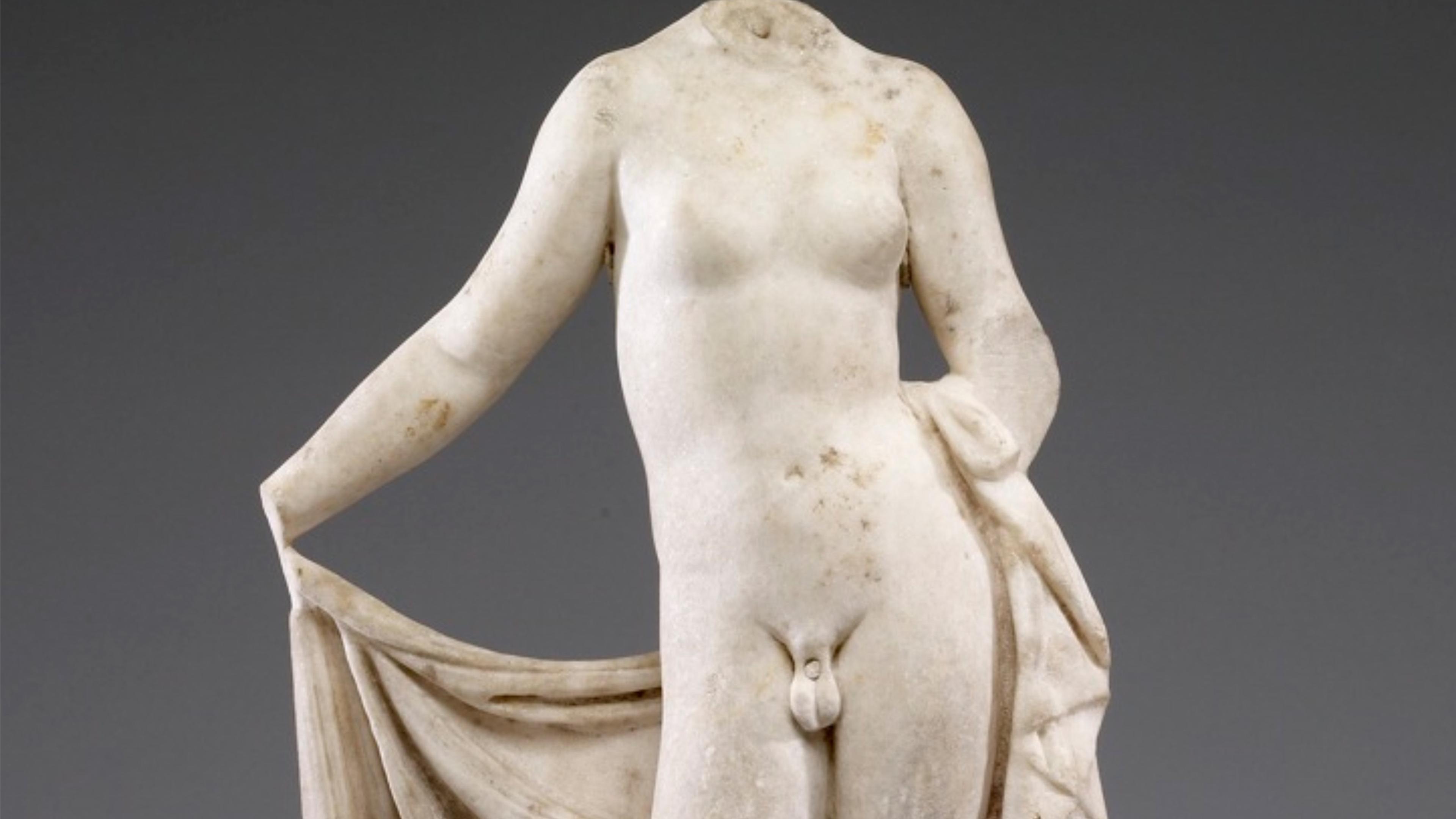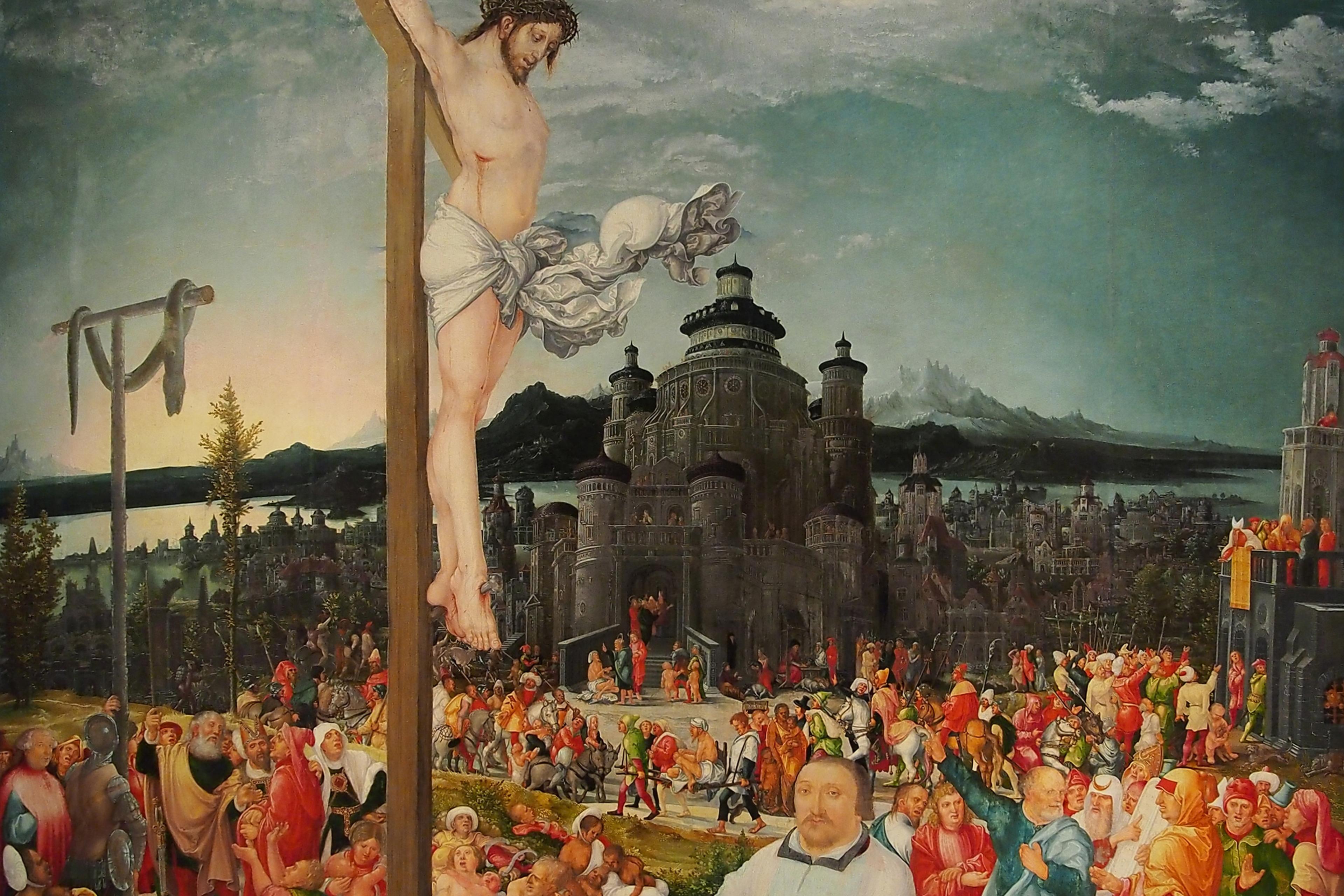Nestled inside the Greek and Roman Sculpture Gallery on the ground floor of the Ashmolean Museum in my home city of Oxford, you will find an intriguing statue. Dating back to the 2nd century CE, the graceful white marble carving shows a figure half male and half female. It’s a beautiful object that tells us something very important about human history, because this is a model of Hermaphroditus, child of the god Hermes and goddess Aphrodite – a nonbinary gendered being worshipped in ancient Greece from a time several centuries before the unknown maker took up their hammer and chisel.
As a species, we have an understandable tendency to believe that our modern selves are quite different from our distant ancestors, that new ideas, philosophies and ways of being are constantly being introduced. One of those ways of being, which has increasingly come into the spotlight of late, is that experienced by people who do not identify with a simple male/female division, or who feel that they were born into the wrong sex. It can be difficult, especially for those of us who grew up in an age where such things were rarely discussed, to understand and appreciate a world that might at first sight appear alien, even unsettling. Much has been written about the supposed ‘culture wars’ waged by those of opposing ideologies, and gender nonconformity has found itself the ball in the centre of the scrum. However, evidence reveals that nonbinary identification, gender fluidity and transgenderism have been around for as long as we have existed. They are as normal and natural as homosexuality – another facet of humanity that has still not found equity in many parts of the world.
‘You’re absolutely right,’ agrees the Queer trans writer and academic Kit Heyam, whose book Before We Were Trans: A New History of Gender (2022) earned rave reviews in The New York Times and elsewhere. ‘The whole debate is centred on the idea of this being a modern phenomenon,’ he goes on, ‘so we’re a new trend and you shouldn’t take it seriously, or we’re a new threat and you need new laws to protect society from us.’ In actuality, our contemporary ways of thinking about gender – ie, that it is something fixed and tied absolutely to the physical body – would appear quite alien to many of our ancestors throughout large parts of our history in numerous places across the world.
At least 6,000 years ago, the earliest known complex civilisation arose in Mesopotamia (present-day Iraq). The Mesopotamians gave us the first example of writing (cuneiform), and many of their daily experiences would be familiar to us. They lived in cities, sent their children to schools, worked day jobs, and enjoyed playing games and music. They also worshipped deities, one of the most important being Inanna, queen of heaven and goddess of sex, war, and justice. Among other things, Inanna possessed the ability to change a person’s gender. Worshippers of Inanna were noted for their gender fluidity. Men who became priests (gala) adopted female names and sung in the feminine dialect. Women who joined the pilipili group of festival performers underwent a similar transformation. As Psyche contributor Moudhy Al-Rashid, junior research fellow at the University of Oxford and specialist on the subject, Tweeted in 2020: ‘Gender fluid identity appears throughout Mesopotamian history, like that of the assinnu, a word sometimes written as a combination of the cuneiform signs for “man” and “woman”.’ In fact, there exists a rich and ancient train of thought that conceptualises a supreme creator who must logically embody both the male and the female, and that therefore humans who follow suit are spiritually advanced.
In India, a third gender exists with a recorded history dating back at least 2,500 years. In Hindu mythology, Lord Rama, one of the most important avatars (incarnations of a deity), was born a prince in the city of Ayodhya. Manipulated by his wicked stepmother into leaving his kingdom, Rama’s adoring disciples sought to follow him into the forest. When Rama commanded: ‘Men and women, please wipe your tears and go away,’ a group of people remained behind – they belonged to neither gender, and waited patiently for their lord to return. Thus, the hijaris earned themselves a special place in Hinduism, and have played an important role in Indian society for millennia. Determined to be of a tritiya prakriti or ‘third nature’, the history of the hijaris is long and complex. As a case study by Harvard Divinity School reveals, for thousands of years they were treated with respect, but this respect was severely damaged by Hinduism’s encounter with colonialism. Astonishingly, in 1871, the British formally declared the hijaris criminals, to be arrested on sight.
The history of Africa, the birthplace of humankind, is also replete with examples of gender nonconformity. The Dagaaba tribe, who originate from present-day Ghana, Burkina Faso and the Ivory Coast, assign gender not based upon anatomy, but upon ‘energy’. For them, it is a person’s ‘vibe’, as kids say these days, that defines their true gender. Within the Dogon tribe of Mali, it is thought that everyone is born with both male and female components. They worship ancestral spirits, known as Nommo or ‘teachers’, who are themselves hermaphroditic. Among South Africa’s famed Zulu, transgender shamans called insangoma tend to religious needs, as is the case with the Lugbara people of the Democratic Republic of Congo, Uganda and South Sudan, and the Ambo tribe of southern Angola and Namibia. Within the latter region, the chibados (or quimbandas) served as male diviners (psychics) who dressed as women and married men. Angola can also boast a gender nonconforming queen, Nzingha Mbande (1583-1663), who ruled the kingdoms of Ndongo and Matamba, led armies, took female wives and kept a harem of cross-dressing men.
Even within Christianity, the idea of a nonbinary God is nothing new
Echoes of the Dagaaba idea of ‘energy’ can be found in the thinking of many Native American tribes. Commonly known as the ‘two spirit’ ethos, the reasoning goes that everything derives from the spirit world, and that therefore those who displayed characteristics of more than one gender had been doubly blessed. Far from being stigmatised, such people are highly respected as especially gifted beings. Even those stereotypically macho brutes, the Vikings, were aware and in some cases accepting of nonbinary persons. Their Norse god Loki himself set an example, with countless mythological tales of the legendary trickster transforming himself between genders and expected gender roles, with one memorable tale having him take on the guise of a milkmaid for several years. Without a doubt, Viking culture was aggressively patriarchal, but they certainly understood the concept of gender fluidity, and documented examples exist of such people living within their societies.
Even within Christianity, although historically subsumed within patriarchal Church traditions, the idea of a nonbinary God is nothing new. An official statement by the Church of England reinforces that idea: ‘Christians have recognised since ancient times that God is neither male nor female.’ Countless passages in the Bible can be found where female imagery is employed as part of the word of God. As the Old Testament has it: ‘As one whom his mother comforts, so I will comfort you.’ In the book of Genesis, God refers to himself in the plural: ‘Let us make humankind in our image.’ As far back as the 1300s, the English visionary anchoress and composer Julian of Norwich explicitly spoke of God as Mother.
Returning to ancient Greece, we know from the Roman writer Macrobius (quoting the Greek historian Philochorus) that, during festivals dedicated to the deity Aphroditus, male and female worshippers exchanged clothing and assumed the role of their opposite gender. Aphroditus later became known as Hermaphroditus, from whom we derive the word ‘hermaphrodite’, meaning a plant or animal that has both male and female characteristics. A little earlier in Greek history, we find the mother goddess Kybele, whose male eunuch priests (gálloi or galli, in Latin) wore traditionally female clothing, hairstyles, makeup and earrings. Ancient Rome itself may well be able to lay claim to a transgender emperor, Elagabalus (c204-222) who, according to Roman historians, preferred using female pronouns and entered into a relationship with a male chariot driver named Hierocles, although debate continues as to the veracity of these claims.
We must sidestep the moral panic that inevitably arises when discussing such matters
Pursuing the theme of historical figures into the medieval period, it’s not hard to find numerous mentions of gender nonconforming persons. One particularly fascinating example takes us to 14th-century London, and a trial concerning one Eleanor Rykener, brought up before the law having been caught performing sex work. This was very unusual in those times, when prostitution was rife in the city. Sodomy, however, was a serious crime, and the reason for Eleanor’s indictment was that the court could not determine if she was indeed a woman. Rykener explained that she had once lived as a man and then had transitioned to the opposite gender. The historians Ruth Karras and Tom Linkinen, writing in Founding Feminisms in Medieval Studies (2016), agree that Rykener should be understood as transgender in the modern sense. Sadly, no verdict was noted and so we have no idea as to Eleanor’s fate.
Given that gender nonconformity has such a long history, how can we reach, or rediscover, a place where nonbinary or trans people are accepted without question? ‘What we need to be talking about with children,’ says Heyam, ‘is that everybody’s bodies are different, and we don’t have to label them in particular gendered ways. And rather than saying “only girls are like this” and “only boys are like this”, we can talk about how everybody is different.’ Part of moving forward must be to sidestep the moral panic that inevitably arises when discussing such matters. As Heyam observes, ‘it starts with having a much more fluid and experimental and low-stakes approach to all kinds of gender nonconformity, allowing people to try things out without jumping down their neck and saying either “This is a phase” or “You have to stick with it for the rest of your life.” Simply allowing people to just play with gender, I think has the capacity to liberate everybody.’
In an increasingly divisive world, rediscovering ancient ways of thinking, ironically, could move us forward toward a more equitable future.








